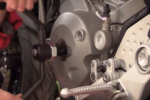How to Load a Motorcycle in a Pickup
How to Load a Motorcycle By Yourself
Maybe I’m just a product of my environment. Growing up in the Rocky Mountain west, we were always taught to be, self sufficient, able to take care of ourselves without the help of anybody else. As a motorcyclist, that means we need to be able to transport our motorcycle, on our own, without the help of anybody else. Which is part of why I’ve owned pickup trucks my entire life. And my pickup truck of choice? Well, the Toyota Tacoma, of course. The same basic thing as the Toyota Hilux for our international readers.

Now, a pickup truck isn’t a requirement. Vans are also an excellent choice and the choice of most club racers. So is owning a trailer. But if space and resources are limited, nothing really beats the humble pickup truck. And no, you don’t need a long bed so you can close the tailgate. A short bed pickup works just fine.
I also want to do a shoutout to BikerMiki we were DM-ing online about transporting motorcycles and it was basically her idea we re-did this video.
So, we’re going to load a full-size motorcycle into the back of a mid-size pickup truck, with a short bed, without the help of another human being. But there are a few things that do make the task easier.
This is a Ready Ramp. No affiliation, I’ve owned this one for coming up on twenty years now, this is this ramps third pickup. It folds into thirds and does double duty as a bed extender.

This is a simple step-stool tool box. I’ve had this since I was sixteen. No tools inside, but a perfect place for extra straps.

Finally, this isn’t necessarily a requirement, but a wheel chock sure helps. Yes, a Baxley is a better product, but this Harbor Freight wheel chock for $70 gets the job done and costs a lot less.

We’re also going to need the best tie-down straps known to man. No affiliation, but Pro Taper makes the best tie downs straps there is. And I know this is going to controversial, but do not, please do not use, we strongly discourage the use of ratchet straps.
There is no good way to release them. They release all at once. A lifetime of being around motorcycles, I will not use ratchet straps. Nor will I use just any cheap-freaking ribbon strap from any gas station. We don’t want a 20-thousand dollar motorcycle to fall on it’s side because we cheaped out on straps. No affiliation but CanyonChasers use Pro Taper straps exclusively.

Now, to make our lives easier, we need to reduce the step-in height to the back of the truck. So, put the rear wheels into the gutter. Or roll the front wheels onto a curb, find a hill. There is almost always some environmental feature that we can use to make it easier to step into the back of the vehicle.

Here’s the thing, with the truck level, the tailgate sits at 83 Cm tall. With the rear wheels in a gutter, I can reduce my tailgate height to 55 cm.

Lay out the ready ramp and strap it to the truck so it doesn’t come out from under the bike. And place the step stool about one step away from the back of the truck. Place the wheel chock into the bed of the truck and prepare the straps.

Now, you know how I’m always going on and on about smooth, slow inputs and the first and last five percent? Well, here we go again. We’re going to use the engine, to pull the bike into the back of the truck.

Don’t look down at the bike or directly at the front wheel. Just like riding, we want to keep our eyes up, looking where we want the bike to end up. Glance down at the ramp, but then bring our eyes back up to the wheel chalk.

Then let the engine pull the bike into the back of the truck and into the chock. If you don’t have a chock, you can put the bike on the side stand until you get it tied down but a wheel chock just makes the whole experience that much more stress free.
We always want to transport our bike in neutral. Never leave it in first gear, we don’t want the bike rocking against the transmission. And we always want to have the side stand up. I’ve seen situations where where people trailered the bike on the sidestand and it’s broken the sidestand. It’s broken the frame mount for the sidestand. And sometimes it’ll even punch a hole or dent the bed of the pickup truck.

When it comes to strapping the bike down, I always go for the lower triple-clamp. It’s, by far, the most secure place a bike can be tied down. These Pro-Taper’s do come with an integrated soft-strap and we just want to be careful that we clear any cables or brake lines or wires as we wrap the integrated soft-strap around the lower triple clamp.
If you can’t access the lower triple clamp, then you may need to attach directly to the handlebars. Or sometimes you may need to use something like a Canyon Dancer. But honestly, it’s pretty rare that I can’t access the lower triple clamp.

When it comes to tensioning the straps most people put the bike under way too much pressure, practically bottoming out the forks, which can blow the fork seals and damage things. Especially with ratchet straps. It’s just way too easy to make things too tight with a ratchet strap.
At most we only want to use half to two-thirds of the available fork travel. We still want the suspension to be able to move so that it can damp some of the bigger road bumps as we’re driving.
To get tension, simply pull the bike to the side and snug the strap. Get the bike tied down as upright as you possibly can. We really don’t want the bike leaning, nor do we want one strap under more tension or stress than the other.
To prevent the cam locks from slipping loose, we tie a simple slipknot that wedges into the buckle, then wrap up the excess strap.

But shouldn’t we strap down the back of the bike too? Well, you can. But my experience has been that if we drive mellow, and take it easy it’s just not necessary.
But if you do feel more comfortable with the back of the bike strapped, what we’re trying to do is we need to compress the rear suspension. So whatever we tie down to needs to be able to compress the rear shock.
The ready ramp doubles as a bed extender, and anything we place in the back of the truck, be mindful that it’s not going to slide and hit and damage the bike.
A few things to be aware of. If we encounter wet conditions the straps are likely to slip a little bit and get loose, so pay attention to them. If you are strapping down the rear of the bike, rear-straps will continually come loose and will need to be re-tightened constantly.
Keep an eye on the bike as you drive. If it starts to list to one side or the other, or if a big bump causes the rear tire to hop to one side. Stop and re-center the bike.

Now, to unload. Again, find a spot to lower the back of the truck. Get the ramp and stool in position. And now to release it, this is why I love cam-straps, you simply pull the bike towards you to relieve some of the tension and then you just push the button and slowly release the bike back up.
Do the same on the other side, back and forth until the bike is free. Don’t just hit the button and release one side all at once.

For going back down the ramp. Our first two fingers are going to cover the front brake and we’re going to slowly walk the bike down, using that 1% to 2% of brake pressure to control our speed. Avoid the temptation to look straight down, looking down messes with our balance, keep our eyes up and pay attention to the rear wheel to make sure it’s tracking straight down the ramp. Slow and steady.
And there you have it. You are a self-sufficient, independent motorcyclists, capable of taking care of yourself. This same method works no matter how you are transporting your bike, vans, trailers, whatever. Just always remember, your vehicle will handle differently with an extra 200 kilo’s, or 400 lbs of weight, so drive super mellow when you’re loaded.






